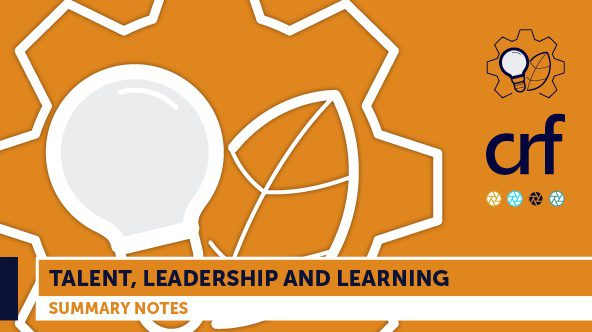Talent, Leadership and Learning
How has the Pandemic Impacted Talent Management?
The pandemic has revealed a new operating context and a new set of challenges for organisations. In this article CRF Learning Director Nick Holley explores how this is impacting both the needs that talent must fulfil and how approaches to attracting, developing and motivating it are evolving.
FORWARD LOOKING VS A HISTORICAL VIEW OF TALENT
For talent management to add value it must take a forward-back view of the world. Where do you need to be in 5 years’ time and what talent will you need to develop and acquire in order to deliver on your strategy?
The historical view of talent with generic, bought in competency frameworks doesn’t focus on the skills the company will require in the future. At best generic talent frameworks are useless, at worst they give a false sense of progress – diverting attention away from focusing on the key talent issues that underpin strategy delivery.
The focus should be on:
- Connecting with the strategy and future of the business, translating insights into capability statements.
- Simulating future scenarios and implications. This is especially true where the pandemic has shown how forecasts change overnight as the context itself changes at speed.
- Moving beyond a purely management or leadership view of talent to consider the critical skills (often technical in nature) that will be required to create a sustainable competitive position. Then, offering a career proposition to them that doesn’t push them into people leadership roles that they don’t enjoy and are bad at.
- Focusing on the key capabilities that are critical to the future, and not trying to do everything at once.
- Centralising the talent process to allow you to look horizontally and vertically through the company as opposed to operating in silos. For example, in some cases organisations are equalising mobility so global covers the costs to make it attractive for local companies to take expats where growth requires a strong expat presence but when this may impact the local company’s short-term profitability. Organisations need to encourage general managers to look at long-term sustainability of talent when they may only be around for the short term, to have global continuity of long-term talent agenda when local management turns over.
- Using data to generate insights. Data analysis can also provide some interesting backward-looking insights into what actually does make a difference. In one company example – looking back over eight years of assessment centres and correlating with career success showed that only one competence really made a difference – learning agility.
- Understanding what broad strategic statements really mean. As an example ‘solution selling’ isn’t just about rebadging and retraining your sales force it has massive capability implications that need to be translated into a fully integrated talent solution.
TALENT HAS THE POWER NOW
The growth and ubiquity of social media has changed the power equation, meaning real talent now has power rather than the organisation. Sites such as Glassdoor are making the employee experience transparent whilst social media platforms such as LinkedIn allow any employee to be active in the job market.
Add to that, key talent shortages in specific industries and specific skills in certain geographies and we find that we often need talent more than they need us. In that environment you can’t rely on loyalty.
The people who really should be in the top right-hand box of our nine-box matrix don’t work in corporate life so we need to be more realistic about what talent we can attract or build different relationships with talent we need that doesn’t want to work in corporate life.
To this end, we have to view talent in different ways. No longer is just about internal contracted employees but instead an ecosystem of talent with different contractual relationships. This includes acquiring individual talent but also acquiring businesses to get hold of their talent.
If talent has the power we have to be responsive to their needs as individuals. We need to look at talent not as segments but as a market of one. Gen Y may have meaning in some contexts in others it’s irrelevant. Don’t pigeonhole but understand who really matters and what really matters to them. We need to move from delivering things at people to creating a climate in which talent is nurtured, challenged and enabled to blossom
If climate matters, we need to upskill managers to create this climate not see development as something HR does to people but something they do in the present with their people every day. Again, this means working with individual managers to support them if they manage talent well or understand why if they don’t – don’t want to, don’t see the need to, don’t know how to, don’t have the confidence – and react accordingly rather than sheep dip them through yet another process.
Enrol Now
For CRF Learning’s Integrated Talent Management Open Programme (15 – 17 November)
IT’S NOT THE PROCESS STUPID
We focus too much on process to the exclusion of outcomes. In fact, process can give a false sense of security – we think we’re making a difference when the only difference we are making is wasting time and money collecting data that either isn’t analysed or isn’t acted on.
Nick Kemsley, a global talent expert, explained how one major global organisation boasted about their great succession planning process. In their top 300 roles they had 96% with one named immediate successor, one named successor within one year and two named successors within 5 years. When he asked them in what percentage of times was a successor named in their succession plan actually placed into an open role the answer was 8%. Think of the amount of time spent populating those roles and the false sense of security 96% gave them. They thought they had a great process but 8% shows they didn’t have a great outcome. Complex processes alienate the key people – the leaders who need to drive actions. Indeed, we blame leaders for not getting engaged with Talent Management when it is the over complicated process that stops them engaging. The danger is the centralised process is so complex people do their own local processes resulting in lost synergies. We must simplify to the key things we need to develop to deliver the strategy.
SUCCESSION PLANNING IS DEAD
We need to move from succession plans to consider the experience we need to build as a company and the experience individuals need to build to succeed. We then need to provide these multiple experiences, presenting this as talent pools not succession plans. It means focusing talent development and creating stretch developmental experiences through projects, secondments, work shadowing, mentoring or career moves.
A focus on succession planning drives a view, that ‘build’ is better than ‘buy’. Why? It may be where you require continuity, but it also may build an internal view of the world when the external world is changing at light speed. It might work where you have a strong internal talent pipeline but maybe you need to look at the external market due to lack of historical investment in internal talent or underinvestment during the pandemic. We must chase out the ‘build is better than buy’ dogma and focus on what works best in our market against our future needs.
Leadership engagement is the key. Nothing matters if you don’t have the involvement and commitment of leaders. We have to be smarter in how we get commitment and we need our HR people to be more influential.
Making external linkages, linkages to shareholder value, linkages to customer credibility, linkages to strategic capability constraints, is probably a better way to do this than an internal talent and HR driven perspective.
- Sell on successes don’t sell the process
- Non-executives can be a good way in
- Involving leaders in assessing talent can be a helpful starting point, as they begin to see what talent really mean and it highlights for them the talent agenda in a real way rather than just numbers in a data table.
- Involve them in developing processes and frameworks so they own it. Better to have 100% commitment to an 80% process than zero commitment to your ‘perfect’ process.
THE BRAIN IS A MUSCLE TO BE DEVELOPED
The latest developments in neuroscience have major implications for our definition of talent. People are not talented or not. Whilst recognising there are some people who will never or simply don’t want to make it, we also need to recognise that latent talent, when nurtured, can blossom in unexpected people and places. So we need to be willing to be proven wrong about talent. It’s not about picking the right person for the right job but about creating the environment in which they can grow and develop.
CREATE A BIGGER POND
In many cases there is a dearth of talent, often technical, alongside an inability of talent to work in a corporate environment. One option is to bemoan a lack of government investment. The other option is to engage with talent much earlier in their life cycle.
I have seen some amazing examples of working with universities and even schools to co-create technical education programmes. I saw examples of moving recruitment from graduation to schools, offering apprenticeships and degree sponsorship. In many cases they invest in business and soft skills that are lacking in formal education to prepare them for the new world of work.
WE NEED A NEW BREED IN TALENT MANAGEMENT
The trends outlined in this article means we need a very different breed of HR person to operate in the Talent Management space. They need to be:
- More pragmatic and less dogmatic to really understand their business and not be driven by an external academic view of talent management
- More future focused and more agile
- More data driven and more tech savvy
- More externally connected and more internationally focused, not just where you operate but where you source talent
- More systemic and better able to integrate thinking and people. This means not seeing talent as a separate activity but as an integrating theme that runs through everything we do in HR.
- More politically savvy so they can link up competing internal power bases within HR into one solution, whilst also recognising the local power issues created by a culture of top-down short-term results.
- More impactful and assertive so leaders at every level engage with the Talent Management agenda as a business necessity
- More self-confident so they don’t see the need to own the process but are happy to facilitate a process owned by the business
Over the last few weeks, I have read a lot of coverage about the ‘great resignation’. A recent Gallup survey found that 48% of workers in the US are actively searching for new job opportunities. In May alone 3.6 million people quit their jobs, and in July UK job vacancies reached 1 million for the first time.
As economies open up and talent shortages increase, the real power now lies in the hands of talent itself. It has therefore never been more critical that we take an integrated approach to talent management.
Register now for CRF Learning’s Integrated Talent Management Open Programme, from 15 – 17 November. The programme will update your knowledge of the latest talent trends, and develop a framework for designing more effective talent approaches. Find out more here.
MEMBER LOGIN TO ACCESS ALL CRF CONTENT



